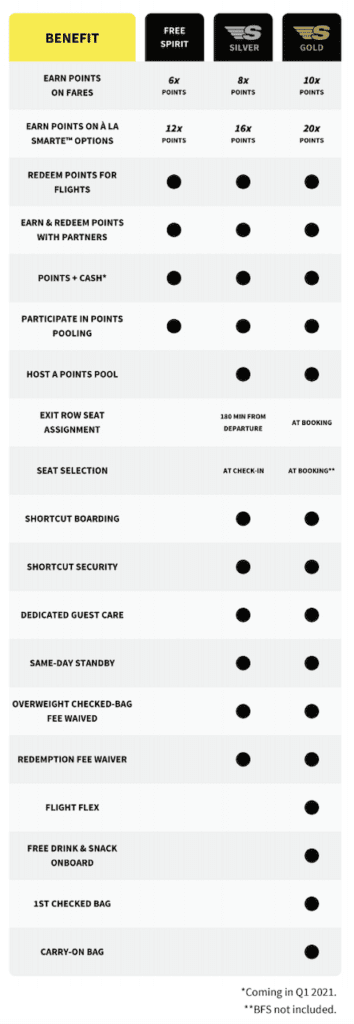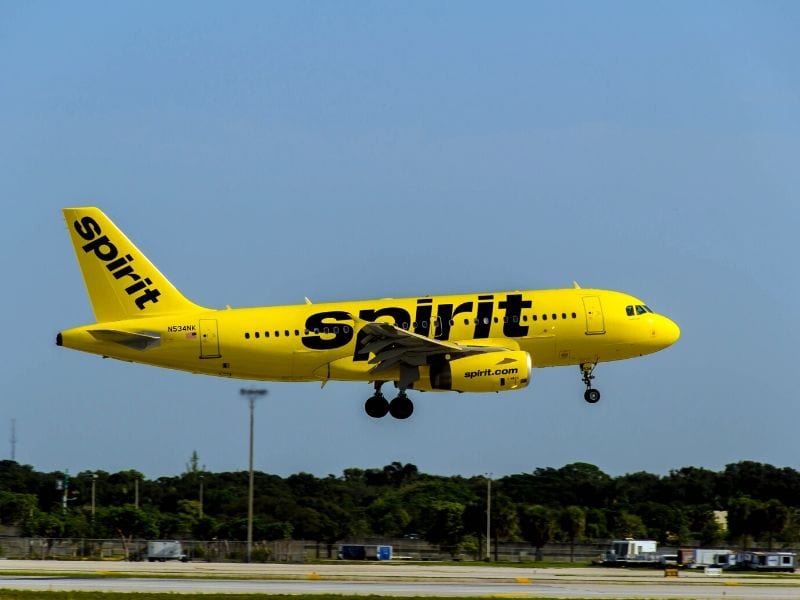Spirit Airlines announced a new loyalty program yesterday. While you might have avoided Spirit in the past, here’s why you should care.
Re-Introducing: Free Spirit
Free Spirit may now be one of the most innovative loyalty programs in the US. Their revamped loyalty program (the name stays the same) adds a ton of valuable benefits for one-time flyers as well as for loyalists when the program re-launches on January 21st, 2021. Here are just some of the key benefits:
- Points and Cash redemptions
- Earning points in a pool of up to eight
- Earning (and redeeming) with partners
- Earning Status Qualifying Points (SQPs) on ancillary purchases.
- Any activity within the account extends the expiry of points by one year

None of the other US carriers have these offerings and none in the world have all of them. That’s a pretty compelling product launch. In particular, Spirit is an airline built on ancillary fees, but so are Basic Economy fares from the Big 3 (Delta, United, and American.) However, not only do those carriers fail to incentivize ancillary purchases, some are even prohibited such as early boarding or faster security access. Spirit has gone in the opposite direction, not only giving more points (twice as many) for those purchases, but they also count toward status.
But wait… there’s more.
Even Better for Elites
Free Spirit had three levels of loyalty before: Somebody (any member that signs up), Elite ($1200 spent on Spirit flights or 12,000 miles flown in the last six months), and VIP (double the Elite requirements.) The carrier has replaced those three tiers with: Member, Silver, and Gold. For elite statuses Silver and Gold, the requirements have increased to $2,000 and $5,000 respectively, but the time to accumulate those has been switched to a calendar year. That places just a 4% premium to reach Gold and a 20% reduction to achieve Silver.
What’s more, they made both of those statuses easier to obtain by also enlisting a co-operative credit card waiver. For every $10 spent on Spirit’s new credit card (details coming in December), passengers earn one SQP. If a passenger doesn’t fly Spirit at all but holds the credit card, they will receive Silver at $20,000 in spend and Gold at $50,000.
That seems steep but let’s look at that closer. According to the Bureau of Labor and Statistics, the average American household spends around $2,300/month that could be processed on a credit card or about $27,600/year. If that were on their credit card, the cardholder would have 2,760 SQPs (Silver status achieved) and be just $2,240 in Spirit Airlines spending from Gold. But what do you get with Free Spirit status?
Silver
In addition to all of the benefits that every member gets Silver adds the following:
- Exit seat assigned 180 minutes prior to departure
- Seat selection at check-in
- Shortcut boarding
- Shortcut security
- Priority phone line
- Same-day standby
- Overweight checked-bag fee waived
- Ability to be a “pool pilot”
Gold
Gold status with Free Spirit adds all of the previous benefits but makes two small changes: both seat selection and exit seat assignments are available at booking. Gold then adds these:
- Flight flex included (one time change 24+ hours prior to departure for free)
- Free drink & snack onboard
- First checked bag free
- Carry-on bag free
Why You Should Care
Given the details above and Spirit’s service advantages, there’s no better time to consider Spirit. The major hotel chains have offered points and cash redemptions for a few years, but airlines haven’t. This helps those who may be at a lower accumulation threshold to spend their points when before they wouldn’t be able to derive value. The same is true for points earned from a single trip with a family. Individually, they likely don’t have enough for a redemption, but when pooled together, they may be able to buy a ticket for future travel with the pooled points.
Many of the status benefits are aligned with what the Big 3 offer their most-loyal customers. Preferred seating, priority boarding, priority phone lines, and same-day standby. But those don’t apply to most of the Basic Economy fares they sell, whereas they do with Spirit. Only super elites with the Big 3 receive a free snack and drink onboard when in coach and a waiver of overweight bags (American allows up to 70 lbs per checked bag for elites.)
So what if Spirit has a few more features than the major carriers? It’s also easier to achieve status and maintain it. With United, you won’t get many of the benefits when flying on their cheapest fares, with Spirit you do. None of those carriers will waive all flying requirements in exchange for spending, and those that have waivers at all require $25,000 in annual spending instead of $20,000 with Spirit.
But award prices are cheaper too. They start at 2,500 in the new program for a one-way flight compared with 5,000 for American on their cheapest routes, that less than even Southwest when they sell $39 fares. Earning on ancillary charges is a huge game changer. For example, if a roundtrip on Spirit costs $100 and guests add luggage for $30 each way, a comparable fare on American in Basic Economy might start at $160 too, but won’t include the checked luggage, won’t earn miles, nor status. In the new Free Spirit program, the guest would receive more benefits and earn about 1400 points, over halfway to a free one-way ticket. That’s value for casual travelers and elites alike.
Conclusion
Spirit has created a truly innovative program with benefits not elsewhere seen in the US airline loyalty space. The Free Spirit revamp is particularly lucrative for those who spend on ancillary revenue and captures a segment of the market the Big 3 have ignored. Points are more valuable in the Spirit program simply by virtue of being easier to spend and pool together with others. Spirit’s approach to credit card spend blending with direct airline spending is something the major carriers can only hope to catch-up to.
What do you think? Do you like the new program? Will you try Spirit or go for status?

